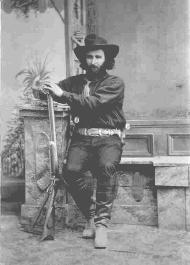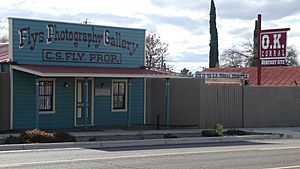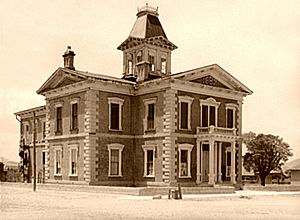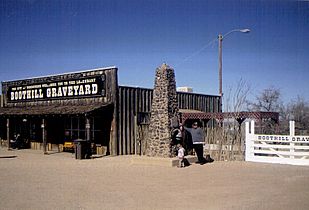Tombstone, Arizona facts for kids
Quick facts for kids
Tombstone
|
||
|---|---|---|

Tombstone in 2018
|
||
|
||
| Motto(s):
The Town Too Tough To Die
|
||

Location of Tombstone in Cochise County, Arizona
|
||
| Country | United States | |
| State | Arizona | |
| County | Cochise | |
| Founded | 1879 | |
| Incorporated | 1881 | |
| Area | ||
| • Total | 9.25 sq mi (23.96 km2) | |
| • Land | 9.25 sq mi (23.96 km2) | |
| • Water | 0.00 sq mi (0.00 km2) | |
| Elevation | 4,406 ft (1,343 m) | |
| Population | ||
| • Total | 1,308 | |
| • Density | 141.37/sq mi (54.59/km2) | |
| Time zone | UTC−07:00 (MST (no DST)) | |
| ZIP Code |
85638
|
|
| Area code | 520 | |
| FIPS code | 04-74400 | |
| GNIS feature ID | 2412081 | |
Tombstone is a city in Cochise County, Arizona, United States. It was founded in 1879 by a prospector named Ed Schieffelin. Tombstone quickly became one of the last "boomtowns" in the American frontier. A boomtown is a town that grows very fast because of a sudden economic boost.
The town grew a lot in the mid-1880s. Local mines produced huge amounts of silver, worth $40 to $85 million. This made it the biggest silver mining area in Arizona. Its population jumped from 100 to about 14,000 in less than seven years! Tombstone is most famous for the Gunfight at the O.K. Corral. Today, most of its money comes from tourism.
Contents
Tombstone's Early Days
The town of Tombstone was built on a flat-topped hill called Goose Flats. This was right above the Goodenough Mine. Just two years after it started, Tombstone had many businesses. It had a bowling alley, four churches, a school, and two banks. There were also three newspapers and an ice-cream parlor.
But there were also 110 saloons and 14 gambling halls! All these businesses were built among the many silver mines. People in Tombstone could enjoy operas at the Schieffelin Hall opera house. Miners and cowboys watched shows at the Bird Cage Theatre.
Conflicts and the Famous Gunfight
Life in Tombstone wasn't always peaceful. There were disagreements that led to serious trouble. Many mine owners and townspeople were Republicans from the Northern states. Many ranchers, some of whom were also cattle thieves, were Democrats from the Southern states.
The city was only about 30 miles from the U.S.–Mexico border. This made it easy for a group of outlaws, known as The Cowboys, to steal cattle from Mexico. The Earp brothers—Wyatt, Virgil, and Morgan—along with Doc Holliday, arrived in Tombstone in 1879 and 1880.
The Earps had many arguments with Cowboys like Ike and Billy Clanton, Frank and Tom McLaury, and Billy Claiborne. These arguments grew worse over months. They finally led to a shootout on October 26, 1881. This famous gunfight is often shown as happening at the O.K. Corral. But it actually happened a short distance away on Fremont Street.
Decline and Survival
In the mid-1880s, water started flooding the silver mines. Mining companies spent a lot of money on special pumps to remove the water. But in 1886, a fire destroyed the main pump house. It was too expensive to rebuild the pumps.
The city almost became a ghost town. But it was saved because it was the county seat of Cochise County until 1929. This meant important government offices were still there. The city's population dropped to a low of 646 people in 1910. But it grew back to 1,380 by 2010. Tombstone is often known for its unusual name.
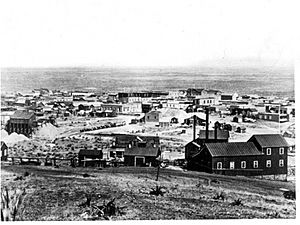
How Tombstone Was Founded
Ed Schieffelin was a scout for the U.S. Army. He often looked for valuable rocks in the wilderness. Other scouts warned him that the only thing he'd find out there was his own "tombstone."
In 1877, Ed found pieces of silver ore in a dry riverbed. It took him months to find where the silver came from. When he found the main vein, it was huge! He partnered with William Griffith, who helped him officially claim the land. Ed named his first claim "Tombstone" on September 3, 1877.
The first small settlement was near the Lucky Cuss mine. It had about 100 people living in tents and wooden shacks. When more silver was found, a new town site was planned on Goose Flats. This was a flat hill high above the Goodenough Mine. The tents and shacks were moved to this new spot.
In March 1879, the town of Tombstone was officially founded. It was named after Ed Schieffelin's first silver claim. By the fall of 1879, thousands of people lived in this growing mining camp.
When Cochise County was created in 1881, Tombstone became its new county seat. This meant it was the main town for government business. In 1880, Ed Schieffelin and his partners sold their mining company to investors from Philadelphia. The Tough Nut Mine, one of their mines, was found to have very rich silver ore.
In September 1880, the fancy Grand Hotel opened. It had beautiful paintings and fine furniture. At its busiest, Tombstone had about 10,000 people. The city had many nice places, like Kelly's Wine House with wines from Europe. It also had a bowling alley and other things you'd find in big cities.
Early Troubles in Tombstone
There were many tensions in Tombstone. Most of the "Cowboys" were from Southern states and supported the Confederacy. The mine owners, business people, and lawmen like the Earps were mostly from Northern states and supported the Union. There was also a big difference in how they thought about land and government.
In the early 1880s, stealing cattle and smuggling goods across the U.S./Mexico border was common. This border was only about 30 miles from Tombstone. The Mexican government had high taxes, so smugglers made a lot of money. This illegal trade made the area very wild.
Many of these crimes were done by a group called the "Cow-boys." They were a loose group of friends who helped each other with crimes. Back then, calling a real cattle rancher a "Cowboy" was an insult. But the Cowboys were still welcome in town because they spent a lot of money. Shootings were a common sight.
Silver Mining in Tombstone
Tombstone grew very fast because of its silver. But the founder, Ed Schieffelin, was more interested in finding new ore than owning mines. Ed and his partners sold their share in some mines for a lot of money. For example, they sold part of the Contention claim for $10,000, which later produced millions in silver. They also sold their share of the Tough Nut mine for $1 million.
There were hundreds of mining claims around Tombstone. The most successful ones were just south of town. These included the Goodenough, Toughnut, Contention, and Lucky Cuss mines. Since there wasn't much water near Tombstone, mills to process the silver were built about 9 miles away along the San Pedro River. This led to other small towns like Charleston and Fairbank.
It's hard to know exactly how much silver and gold was mined in Tombstone. But it's estimated that the mines produced 32 million troy ounces of silver. This was more than any other mining area in Arizona! Some estimates say the mines produced between $40 million and $85 million in silver.
Because so much money was being made, many lawsuits happened. Between 1880 and 1885, courts were full of cases about land claims. This meant many lawyers moved to Tombstone and became even richer than the miners. Experts like geologists also came to map the mines. This led to very detailed maps of Tombstone's mining claims.
In the early days, mining was easy because the silver was close to the surface. One miner could dig out as much ore as three men elsewhere. Many people in Tombstone became very rich. They spent a lot of money during the town's boom years.
Tombstone's first newspaper, the Nugget, started in 1879. The Tombstone Epitaph began in 1880. As the town grew, many professionals and merchants moved there with their families. They brought churches and a more formal way of life. People in Tombstone dressed well and had access to many goods. Miners were often immigrants from Europe. Chinese people did laundry and other services. The Cowboys controlled the countryside and stole cattle from Mexico.
The railroad was supposed to come to Tombstone, but it never did. This kept the city somewhat isolated. Tombstone also became known as one of the most dangerous places in the West. Water was brought in by wagons until a 23-mile pipeline was built from the Huachuca Mountains in 1881. Soon after the pipeline was finished, the silver mines hit water.
Tombstone's Growth and Decline
By mid-1881, Tombstone had fancy restaurants and a bowling alley. It had four churches, a school, and the Schieffelin Hall opera house. There were also two banks, three newspapers, and an ice cream parlor. But it still had 110 saloons and 14 gambling halls! The city also got its first telephone service in March 1881.
Investors from the northeastern United States bought many of the big mining operations. The miners themselves were mostly immigrants from Europe. Chinese and Mexican workers provided services like laundry and cooking. But some people formed an "Anti-Chinese League" to protest against Chinese businesses.
The mines worked three shifts a day. Miners earned $4.00 a day for six 10-hour shifts a week. The 6,000 men working in Tombstone earned over $168,000 a week. This money was often spent on Allen Street, the main business area, which was open 24 hours a day.
People could watch traveling theater shows at Schieffelin Hall, which opened in June 1881. On December 25, 1881, the Bird Cage Theatre opened on Allen Street. It was famous for its shows and even hosted Cornish wrestling matches.
By late 1881, Tombstone had over 7,000 citizens. At its peak, the official population reached about 10,000. In 1882, the Cochise County Courthouse was built.
Fires in Tombstone

Tombstone had two big fires because buildings were poorly made and fire protection was bad. On June 22, 1881, the first fire destroyed 66 businesses. It started when a lit cigar set a barrel of whiskey on fire in a saloon.
On May 25, 1882, an even worse fire started in a Chinese laundry. It destroyed the Grand Hotel and many other businesses. It burned over 100 businesses and most of the downtown area. There wasn't enough water to put out the fire. So, buildings in the fire's path were blown up with dynamite to stop the flames from spreading. The damage was estimated at $700,000. But people started rebuilding right away.
Mines Flood with Water
The Tough Nut Mine started leaking water in 1880. In March 1881, the Sulphuret Mine hit water at 520 feet deep. A year later, in March 1882, miners in the Grand Central Mine hit water at 620 feet. At first, it wasn't a lot of water. But experienced miners knew it would get worse, and it did. Soon, even big pumps couldn't keep up. The silver ore was underwater.
Mine managers bought huge Cornish engines, which were special pumps used in other mines. By early 1884, these engines were pumping out 576,000 gallons of water every day. The town celebrated because mining could continue. However, the Contention and Grand Central mines were draining water for other mines too. But those other companies refused to help pay for the expensive pumps.
On May 26, 1886, the Grand Central pump house burned down. The fire was so hot that the metal parts of the Cornish engine melted. The main mine shaft was also destroyed. Soon after, the price of silver dropped to 90 cents an ounce. Mines that were still open had to lay off workers. Many people who had thought about leaving Tombstone now did. The price of silver went up a little later, and some mines reopened, but they never reached their old levels.
Tombstone Today: Tourism
The U.S. census showed fewer than 1,900 people in Tombstone in 1890. By 1900, there were fewer than 700. Tombstone was saved from becoming a ghost town because it remained the county seat until 1929. That's when county offices moved to nearby Bisbee. The old Cochise County Courthouse and its gallows yard are now a museum.
Life in Tombstone was quiet in the 1930s and 1940s. But the town became popular again in the 1950s and 1960s. This was thanks to movies, TV shows, and comics about the Wild West. Today, tourism is the main business. A 2005 article said that Tombstone gets about 450,000 tourists each year. That's about 300 tourists for every person who lives there! Unlike its busy past, Tombstone is now a quiet town with few businesses open late.
Tombstone has many places to stay, restaurants, and attractions. It's also close to other interesting historic sites like Bisbee. Sierra Vista, a bigger city with more shopping, is also a short drive away.
East Allen Street is the main tourist area. It has three blocks of shaded boardwalks with gift shops, saloons, and places to eat. The historic part of Allen Street is closed to cars. It runs from 3rd Street, where the city park and OK Corral are, to 6th Street, where the Bird Cage Theatre is. Other interesting places are found throughout the city, including Boothill Cemetery on Highway 80.
Wild West Shows
Shows and events help keep the town's Wild West image alive. They also bring new visitors. The historic O.K. Corral is still there, but it's now surrounded by a wall. Fremont Street, where parts of the gunfight happened, is open to the public. Mannequins show where the people stood during the gunfight. Visitors can pay to watch a reenactment of the famous shootout. Helldorado Days is Tombstone's oldest festival. It celebrates the town's wild past from the 1880s.
The World's Largest Rosebush
According to Guinness, the world's largest rosebush is in Tombstone. It was planted in 1885 and still grows well in the sunny climate. This Lady Banksia rose came from Scotland. Mary Gee, whose husband worked for a mining company, received rooted cuttings from her family. She planted one rose by the patio of the mining company's boarding house.
This building was later called the Cochise House Hotel. From 1909 to 1936, it was known as the Arcade Hotel. By the 1930s, the rosebush had grown so big it shaded the whole patio. It became a popular spot for tourists. The hotel was later renamed the Rose Tree Inn and then the Rose Tree Inn Museum. The museum says that all Banks roses in the U.S. today came from this Tombstone rose.
In 1940, the rosebush covered about 4,000 square feet. By 2014, it covered over 8,000 square feet of the inn's roof and garden. Its trunk is 12 feet around! The rosebush is behind a wall, and the inn charges a small fee to see it.
There are also two huge rose "trees" at Tombstone's historic Sacred Heart Church. They were also planted in the 1880s and shade a 2,500 square foot courtyard.
Tombstone's Historic District
The Tombstone Historic District is a special area recognized as a National Historic Landmark District. It got this honor in 1961 because it was "one of the best preserved examples of a rugged frontier town from the 1870s and '80s."
However, in 2004, the National Park Service warned that Tombstone's historic status was at risk. This was because of changes that didn't fit the historic look of the town.
Some of the changes that worried the National Park Service included:
- Putting "historic" dates on new buildings.
- Not making it clear which buildings were new and which were old.
- Covering old buildings with new, unsuitable materials.
- Replacing old parts instead of fixing them.
- Adding new features that didn't match the original style.
- Building new structures that didn't fit in the historic area.
- Using bright, blinking lights on historic signs.
- Adding things like hitching rails and Spanish tile porches that weren't there originally.
Important historic buildings include Schieffelin Hall, an opera house built in 1881. The Cochise County Courthouse was empty for many years after the county seat moved to Bisbee. In 1955, a group bought the courthouse and turned it into a historical museum. It opened in 1959 and shows exhibits and thousands of items from Tombstone's past.
The Crystal Palace Saloon, with its 45-foot long mahogany bar, was rebuilt in 1964. It was made to look just like it did in 1881, with large Victorian lamps and a patterned wood floor.
Geography and Climate
Tombstone is located on a flat-topped hill (mesa) about 4,539 feet above sea level. It sits in the San Pedro River valley, between the Huachuca and Whetstone Mountains to the west, and the Mules and Dragoon Mountains to the east. The city covers about 11.2 square kilometers of land.
The silver-rich Tombstone Hills around the city were formed by volcanic rock pushing through limestone. The silver ore found here was easy to process. It contained a lot of lead, sometimes as much as 50 percent of the ore. The silver content was very high, worth up to $105.00 per ton in 1881 money.
Tombstone has a typical Arizona semi-arid climate. This means it's usually dry. It has three main seasons. Winter (October to March) has mild to warm days and chilly nights. Temperatures can drop below 32°F about 28 nights a year. Snowfall is very rare. The coldest temperature ever recorded was 3°F in December 1978.
The summer season (April to June) is very dry and gets hotter. The hottest temperature ever recorded was 112°F in July 1989. Then comes the monsoon season (July to September). This is when Tombstone gets most of its rain. The wettest month ever was July 2008, with 11.53 inches of rain.
| Climate data for Tombstone, Arizona, 1991–2020 normals, extremes 1893–present | |||||||||||||
|---|---|---|---|---|---|---|---|---|---|---|---|---|---|
| Month | Jan | Feb | Mar | Apr | May | Jun | Jul | Aug | Sep | Oct | Nov | Dec | Year |
| Record high °F (°C) | 86 (30) |
96 (36) |
92 (33) |
99 (37) |
104 (40) |
110 (43) |
112 (44) |
106 (41) |
106 (41) |
100 (38) |
91 (33) |
84 (29) |
112 (44) |
| Mean maximum °F (°C) | 72.7 (22.6) |
77.0 (25.0) |
83.5 (28.6) |
89.7 (32.1) |
97.0 (36.1) |
103.5 (39.7) |
103.0 (39.4) |
99.3 (37.4) |
96.6 (35.9) |
91.7 (33.2) |
82.1 (27.8) |
74.1 (23.4) |
104.8 (40.4) |
| Mean daily maximum °F (°C) | 61.6 (16.4) |
64.3 (17.9) |
71.3 (21.8) |
78.6 (25.9) |
86.9 (30.5) |
96.1 (35.6) |
94.0 (34.4) |
91.6 (33.1) |
89.0 (31.7) |
81.4 (27.4) |
70.3 (21.3) |
61.0 (16.1) |
78.8 (26.0) |
| Daily mean °F (°C) | 49.6 (9.8) |
52.2 (11.2) |
57.7 (14.3) |
64.0 (17.8) |
72.0 (22.2) |
81.0 (27.2) |
81.2 (27.3) |
79.4 (26.3) |
76.3 (24.6) |
67.9 (19.9) |
57.7 (14.3) |
49.4 (9.7) |
65.7 (18.7) |
| Mean daily minimum °F (°C) | 37.6 (3.1) |
40.0 (4.4) |
44.0 (6.7) |
49.4 (9.7) |
57.0 (13.9) |
65.8 (18.8) |
68.4 (20.2) |
67.2 (19.6) |
63.6 (17.6) |
54.4 (12.4) |
45.1 (7.3) |
37.7 (3.2) |
52.5 (11.4) |
| Mean minimum °F (°C) | 24.2 (−4.3) |
26.1 (−3.3) |
30.1 (−1.1) |
35.0 (1.7) |
44.5 (6.9) |
55.3 (12.9) |
61.4 (16.3) |
60.2 (15.7) |
54.6 (12.6) |
39.9 (4.4) |
29.3 (−1.5) |
24.3 (−4.3) |
20.9 (−6.2) |
| Record low °F (°C) | 6 (−14) |
5 (−15) |
12 (−11) |
23 (−5) |
31 (−1) |
37 (3) |
42 (6) |
53 (12) |
43 (6) |
27 (−3) |
18 (−8) |
3 (−16) |
3 (−16) |
| Average precipitation inches (mm) | 0.82 (21) |
0.70 (18) |
0.71 (18) |
0.21 (5.3) |
0.24 (6.1) |
0.64 (16) |
3.03 (77) |
3.07 (78) |
1.61 (41) |
0.64 (16) |
0.62 (16) |
0.93 (24) |
13.22 (336.4) |
| Average snowfall inches (cm) | 0.5 (1.3) |
0.1 (0.25) |
0.0 (0.0) |
0.0 (0.0) |
0.0 (0.0) |
0.0 (0.0) |
0.0 (0.0) |
0.0 (0.0) |
0.0 (0.0) |
0.0 (0.0) |
0.4 (1.0) |
0.2 (0.51) |
1.2 (3.06) |
| Average precipitation days (≥ 0.01 in) | 4.1 | 3.9 | 3.0 | 1.3 | 1.3 | 2.9 | 10.2 | 10.8 | 5.7 | 3.1 | 2.5 | 4.3 | 53.1 |
| Average snowy days (≥ 0.1 in) | 0.1 | 0.1 | 0.0 | 0.0 | 0.0 | 0.0 | 0.0 | 0.0 | 0.0 | 0.0 | 0.1 | 0.2 | 0.5 |
| Source 1: NOAA | |||||||||||||
| Source 2: National Weather Service | |||||||||||||
Population and People
| Historical population | |||
|---|---|---|---|
| Census | Pop. | %± | |
| 1880 | 3,423 | — | |
| 1890 | 1,875 | −45.2% | |
| 1900 | 646 | −65.5% | |
| 1910 | 1,582 | 144.9% | |
| 1920 | 1,178 | −25.5% | |
| 1930 | 849 | −27.9% | |
| 1940 | 822 | −3.2% | |
| 1950 | 910 | 10.7% | |
| 1960 | 1,283 | 41.0% | |
| 1970 | 1,241 | −3.3% | |
| 1980 | 1,632 | 31.5% | |
| 1990 | 1,220 | −25.2% | |
| 2000 | 1,504 | 23.3% | |
| 2010 | 1,380 | −8.2% | |
| 2020 | 1,308 | −5.2% | |
| U.S. Decennial Census | |||
In 2000, Tombstone had 1,504 people living in 694 homes. About 20% of homes had children under 18. Almost half (47.6%) were married couples. The average household had 2.17 people.
The population's age spread out like this: 19.3% were under 18, and 23.3% were 65 or older. The average age was 49 years old. For every 100 females, there were about 94 males.
The average income for a household in the city was $26,571. About 17.4% of the population lived below the poverty line. In 2010, the total population was 1,380.
Education in Tombstone
The Tombstone Unified School District serves the city. The schools in Tombstone are Walter J. Meyer Elementary School and Tombstone High School. Tombstone is also part of the Cochise Technology District. This district helps create career and technical education programs for high school students.
Historic Places to See
Many buildings in Tombstone are listed on the National Register of Historic Places. Here are some pictures of these important places:
Images for kids
See also
 In Spanish: Tombstone (Arizona) para niños
In Spanish: Tombstone (Arizona) para niños



